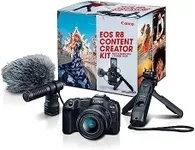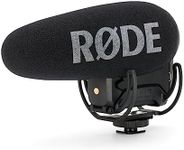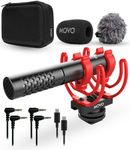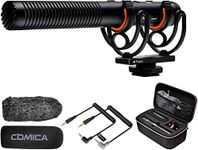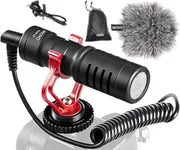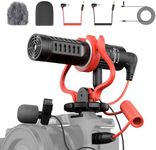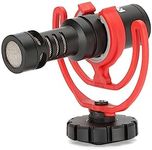Buying Guide for the Best Camera Microphone For Canon
Choosing the right camera microphone for your Canon camera can significantly enhance the audio quality of your recordings. Whether you're a vlogger, filmmaker, or just someone who loves capturing moments, understanding the key specifications of camera microphones will help you make an informed decision. Here are the essential specs to consider when selecting a microphone for your Canon camera.Type of MicrophoneThe type of microphone is crucial because it determines how the microphone captures sound. There are several types, including shotgun, lavalier, and stereo microphones. Shotgun microphones are highly directional and great for isolating sound from a specific source, making them ideal for interviews or vlogging. Lavalier microphones are small and clip onto clothing, perfect for hands-free recording and capturing dialogue. Stereo microphones capture sound from multiple directions, providing a more immersive audio experience, suitable for recording ambient sounds or music. Choose the type based on your recording needs.
Polar PatternThe polar pattern of a microphone describes how it picks up sound from different directions. Common polar patterns include cardioid, supercardioid, and omnidirectional. Cardioid microphones pick up sound primarily from the front, reducing background noise, which is great for focused recording. Supercardioid microphones have an even narrower pickup pattern, offering more isolation from surrounding noise. Omnidirectional microphones capture sound equally from all directions, making them ideal for capturing ambient sounds. Select a polar pattern based on the environment and the type of sound you want to capture.
Frequency ResponseFrequency response refers to the range of frequencies a microphone can capture. A wider frequency response means the microphone can pick up a broader range of sounds, from deep bass to high treble. For general use, a frequency response of 20 Hz to 20 kHz is sufficient, as it covers the range of human hearing. If you're recording specific types of audio, such as music or nature sounds, you might need a microphone with a more tailored frequency response. Consider what you will be recording most often to determine the appropriate frequency response.
SensitivitySensitivity indicates how well a microphone can pick up quiet sounds. A higher sensitivity means the microphone can capture softer sounds without needing to be very close to the source. This is important for recording in quiet environments or capturing subtle audio details. However, in noisy environments, a lower sensitivity might be preferable to avoid picking up too much background noise. Think about the typical recording conditions and choose a sensitivity level that matches your needs.
ConnectivityConnectivity refers to how the microphone connects to your Canon camera. Common options include 3.5mm jacks, XLR connectors, and USB connections. Most Canon cameras have a 3.5mm input, making microphones with this type of connector widely compatible. XLR connectors are typically used in professional audio equipment and may require additional adapters or recorders. USB microphones are generally used with computers but can be compatible with some cameras using adapters. Ensure the microphone you choose is compatible with your camera's input options.
Power SourceMicrophones can be powered in different ways, including battery-powered, phantom power, or plug-in power. Battery-powered microphones are convenient as they don't rely on the camera's power, but you need to keep spare batteries on hand. Phantom power is commonly used with professional microphones and requires an external power source, often provided by audio interfaces or recorders. Plug-in power is supplied directly from the camera, which is convenient but may drain the camera's battery faster. Consider your recording setup and choose a power source that fits your workflow.

